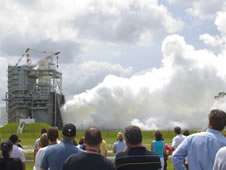Era Ends for Space Shuttle Main Engine Test Program

(PhysOrg.com) -- With 520 seconds of shake, rattle and roar on July 29, NASA's John C. Stennis Space Center marked the end of an era for testing the space shuttle main engines that have powered the nation's Space Shuttle Program for nearly three decades.
This was the final planned test of a main engine for the shuttle, which currently is set to retire next year. More than 34 years ago, on June 27, 1975, Stennis engineers conducted the first test on one of the world's most sophisticated rocket engines.
"It would be difficult to overstate the role Stennis has played in our nation's space program for the last 34 years," Stennis Director Gene Goldman said. "Its workers have created an unparalleled legacy of engine testing excellence."
Overall, in more than three decades of testing, about 50 main engines have been certified for use on almost 130 shuttle missions. These engines can be used to power more than a dozen flights before being retested.
"The excellent flight record of the space shuttle main engine can be largely attributed to the test team at Stennis Space Center," said Ronnie Rigney, acting space shuttle main engine test project manager at Stennis. "We have performed over 2,000 tests, totaling more than 1 million seconds of accumulated hot-fire time in support of the development, certification, acceptance and anomaly resolution for the space shuttle main engine."
At one point, all three test stands at Stennis were involved in shuttle engine testing. Today, testing for the program occurs on the A-2 Test Stand as Stennis engineers prepare the A-1 Test Stand for testing the J-2X engine currently in development. That engine will help power the Ares I and Ares V rockets that will take humans back to the moon and possibly beyond as part of NASA's newest space challenge - the Constellation Program.
NASA assigned Stennis to test space shuttle main engines in 1971. Prior to the first shuttle flight, Stennis engineers conducted some 500 tests on the engine and its components. They also test-fired the three-engine cluster arrangement - the main propulsion test article - that is used to power the shuttle, an accomplishment some called the facility's "finest hour."
In single-engine and cluster testing alike, the goal was the same: eight and one-half minutes of successful firing, duplicating the amount of time it takes the engines to power the shuttle from launch to orbit.
"Stennis Space Center is truly unique in that propulsion test operations expertise has been passed from generation to generation through the Apollo and Shuttle programs since the mid-1960s, making this workforce one of the most knowledgeable in its field," Rigney explained. "This last test of the space shuttle main engine represents great accomplishments for this team, as well as new opportunities and challenges to transition to a new era in the nation's space program."
Provided by JPL/NASA (news : web)
















